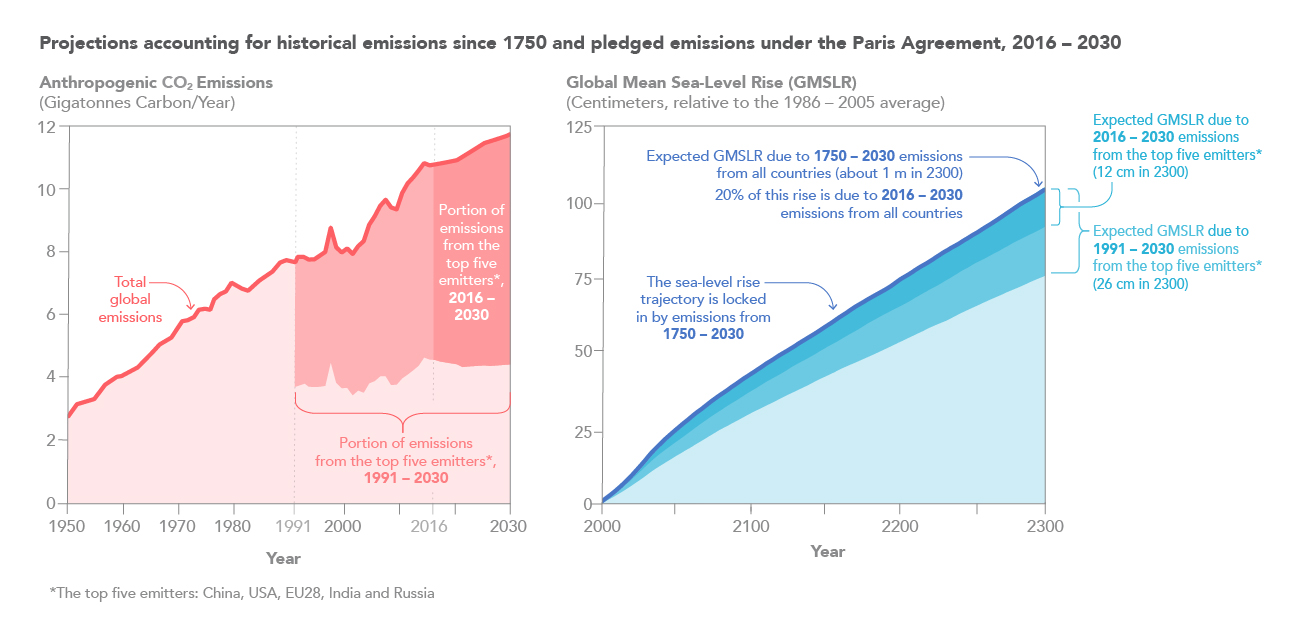Just 15 years of post-Paris emissions to lock in 20 cm of sea level rise in 2300: study
Share

The study, led by researchers at Climate Analytics and the Potsdam Institute for Climate Impact Research (PIK), estimates how much long-term sea level rise will be locked in by 2300 due to past and near-term anthropogenic greenhouse gas emissions up to 2030.
The report is the first to quantify the sea-level rise contribution of anthropogenic greenhouse gas emissions that countries would release if they met their current Paris Agreement pledges (‘Nationally Determined Contributions’ or NDCs). The pledges, made after first adopting the Paris Agreement in 2015, expire in 2030.
The researchers found that emissions released during those 15 years alone would cause sea levels to rise by 20 cm by 2300, one-fifth of the total committed sea-level rise caused by the emissions released from the start of industrialisation up to 2030. The potential impact of an already irreversible melting of parts of the Antarctic ice sheet was not taken into account.
“Our results show that what we do today will have a huge effect in 2300. 20 cm is very significant; it is basically as much sea-level rise as we’ve observed over the entire 20th century. To cause that with only 15 years of emissions is quite staggering,” said Climate Analytics’ Alexander Nauels, lead author of the study.
“The true consequences of our emissions on sea-level rise unfold over centuries, due to the slow pace at which the ocean, polar ice sheets and glaciers respond to global warming. The more carbon we release now the more sea-level rise we are locking in for the future,” Nauels said.
The researchers also found that just over half of the 20 cm contribution can be attributed to the top five polluters – China, USA, EU, India, and Russia. The emissions released by these five countries under their current Paris Agreement pledges (NDCs) will cause seas to rise by 12 cm by 2300, the study shows.
“Just five economies are responsible for more than half of the projected sea-level rise caused by emissions released in the 15 years following the Paris Agreement. In order to limit long-term sea-level rise, it is crucial that these countries step up their emission reduction efforts,” said Johannes Gütschow, from PIK, another author of the study.
When accounting for all the emissions released between 1991, the year after the Intergovernmental Panel on Climate Change (IPCC) published its first scientific assessment of climate change, and 2030, the long-term sea-level rise commitment of the five biggest emitters increases to 26 cm.

Graphic by Lucy Reading-Ikkanda
“The implications of our findings are clear. Emissions today will inevitably cause seas to rise a long way into the future. This process cannot be reversed. It is our legacy for humankind,” said Climate Analytics’ Carl-Friedrich Schleussner, who also contributed to the study.
“Governments urgently need to put forward much stronger emission reduction pledges, or NDCs, by 2020 in order to decarbonise at a pace in line with the Paris Agreement’s 1.5°C temperature goal and avoid further burdening future generations,” Schleussner said.
As seas rise, extreme sea-level events will happen more often and increase flood risks. The recent IPCC Special Report on Oceans and Cryosphere states that extreme sea-level events currently seen only once in a hundred years will occur annually in many parts of the world by 2050 due to the projected sea-level rise of 24-32 cm. This will have potentially devastating impacts for many coastal and island communities.











